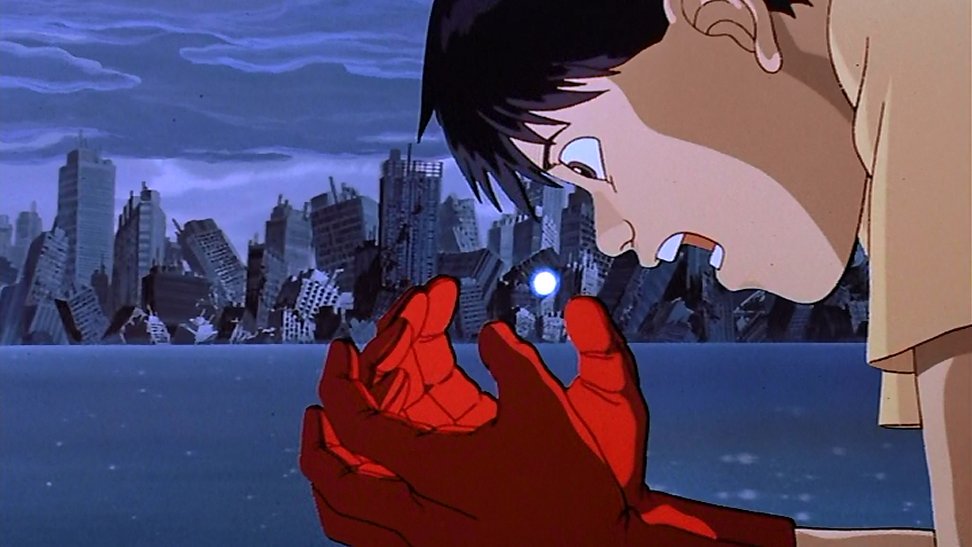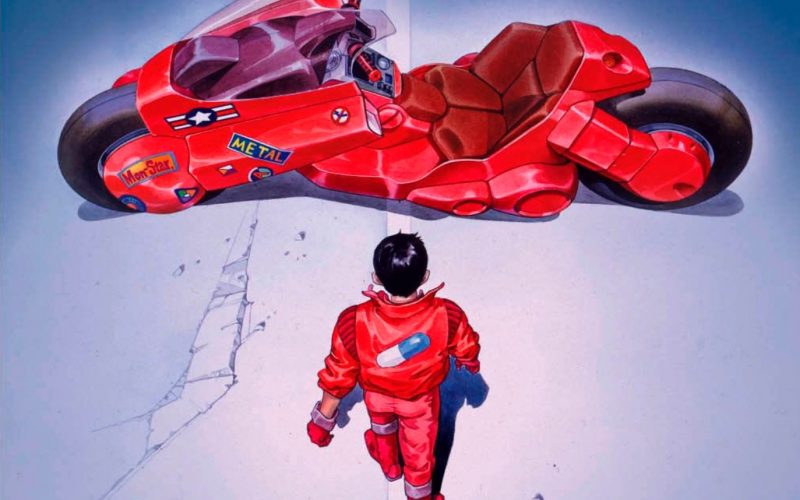Akira (1988).
Japanese animation has had and continues to have an immense influence over western film and television, and there is a handful of works whose mark cannot be overstated. Akira celebrated its thirtieth anniversary earlier this year, and its events take place in 2019, thirty-one years after the destruction of Tokyo that launched World War III. Co-written (with Izo Hashimoto) and directed by the creator of the manga, Katushiro Ôtomo, the film was made on a budget of $9 million (the highest budget of any anime at the time) and differs significantly from the source material due to it not having been completed by the time Otomo was approached to adapt it.

The events of this landmark film take place in Neo Tokyo, 2019, a cyberpunk future that’s both inspired by classics that came before it and has inspired the aesthetics of like-minded films itself ever since. The neon colours of the city skyline do not however make Neo Tokyo appear as some kind of eutopia (which cannot be said for more modern attempts to reinterpret the kinds of visuals seen here and in films such as Blade Runner). Instead, this is a place that’s supposedly peaceful but has become a feeding ground for crime and degradation. The government hopes that the coming Olympic Games may pull the city out from the financial woes that plague the middle and lower classes.

One such criminal element roaming the streets is the rival bike gangs that terrorize one another, inciting plenty of property damage in their exploits. This is where we meed Kaneda, the teenage leader of a small group of kids with a grudge against another gang. While the other members of Kaneda’s crew aren’t particularly memorable, we do meet Kaneda’s more introverted, polar opposite in Tetsuo. Where Kaneda is a natural and outspoken leader, Tetsuo is quieter and far less authoritative. His growing up with Kaneda, for the most part, has led to them developing a rather co-dependent relationship that has seemingly led to Tetsuo’s internal desire to prove himself.

But the street-level exploits of this group of adolescent boys is intentionally inconsequential to the enormity of what’s brewing via a secret government project in which juvenile test subjects are being experimented on in order to better understand what truly happened back in 1988. We hear the name “Akira” scarcely and learn very little about him, or it, until much later. While Kaneda and co. are hunting down the lesser able bike gang, a boy with a strange appearance is being escorted through the city by a desperate and injured man wielding a gun. The way in which these two disparate storylines come together is a classic case of “wrong place, wrong time” for Kaneda and, in particular, Tetsuo, who finds himself on a collision course with the strange child in his attempt to impress the rest of his gang and winds up severely injured.

There’s a hell of a lot of setup, which leads into Tetsuo’s recruitment as the latest test subject and Kaneda’s desire to learn more about Kei, a member of a terrorist organisation trying to expose the government for its underground experiments and whom Kaneda develops a sudden infatuation for. And yet all of this setup is handled efficiently and with flawless execution. The film is a lean 124 minutes long, especially notable given that its story could be considered convoluted without its crisp pacing and solid control over the weaving of its many threads. Kaneda is a particularly flawed protagonist, though in many ways he’s a victim of the poorly governed world that he’s grown up in. Orphaned and mostly living on the streets, he lacks social skills (particularly noticeable when he attempts to flirt with Kei) and harbors a quickfire temperament. He and Tetsuo are perfect foils for one another, and they share a brotherly bond that becomes severely damaged when their paths set them against one another.

Tetsuo, who has never experienced the kind of power, physically or otherwise, that he suddenly finds himself wielding, loses control of himself as he completely embraces his newfound telekinetic abilities. The film comments on both puberty and the corruption of innocence at the hands of the adult world. All of the kids whom we sympathise with are, again, victims of an unsupportive governing body. Late in the film Tetsuo desperately professes that he can’t control his own body, the most on-the-nose demonstration of the film’s exploration of the transition from childhood into adulthood. The nature of Tetsuo’s powers is continually explored, opening up a plethora of thought provoking ideas and prodding our imaginations with the possibilities – that all of the people in the world have this kind of energy running through their bodies, and all it needs is to be awoken. Tetsuo reveals the kind of person he truly is when he makes his decision on how to use his powers, and ultimately proves that he’s a rather small person with base desires and is easily corrupted by his newfound abilities.

But then at the same time we see that Tetsuo is just a scared, confused child, hiding behind a pseudo confidence, desperately trying to convince himself that he doesn’t need the help of those who care about him. He is ultimately the victim in all of this, and yet he causes the kind of widespread destruction and death that would usually define him as the villain of the story. Antagonist, absolutely, though villainy might be a stretch in a film that tests the lines of morality from the very beginning. The protagonist is a criminal and, at times, something of a misogynist. The only female lead with a particularly strong voice is a terrorist whom we witness murder someone without much hesitation (though it takes a toll, even if only briefly). And the colonel that oversees the experiments and ends the film as a war criminal earns our favour despite all that’s come before his somewhat heroic actions.

A mythology is crafted in short time as we learn more about the true nature of Akira and how the events that led to the white singularity came to transpire thirty-one years ago. The three children, the only other living test subjects we meet apart from Tetsuo, all have a mysterious aura about them, and some otherworldly, almost god-like prescience. Answers pertaining to the three of them come at the climax, via a series of flashbacks. As with the reveal regarding Kei, the film offers rather transparent answers that are stirring and wonderfully imaginative even thirty years on. And those answers remain open to some level of interpretation, or at the very least discussion, to this day. The film’s climax is a disturbing and brilliantly animated one and leads to the kind of mind-numbing conclusion that should be spoken about in the same conversation as films like 2001: A Space Odyssey and Blade Runner; its influence can certainly be compared to both.

What marks Akira out as a truly epic work is the incredible amount of effort and craftsmanship that went into it’s beautiful cell animation. Hand-drawn cell animation has fallen out of favour in recent decades, certainly since Pixar’s rise to dominance spawned a cavalcade of CG copycats, but show me an animated film as jaw dropping as Akira and I’ll be impressed. There’s a level of detail in each individually drawn cell and a smoothness to the animation unlike any other traditionally animated film I’ve ever seen. Akira was an immensely time consuming project and Ôtomo, ever the perfectionist, ensured that his film would have a timeless quality to it simply due to the fact that replicating such stunning animation takes a mammoth effort that no other filmmaker would ever likely have the opportunity or resources available to them to ever attempt. The unmatched vibrancy of colour in Akira just pops out of the screen but never looks gaudy and is never at the expense of maintaining a sense of realism to proceedings.

Credit too must go to composers Shôji Yamashiro and Geinoh Yamashirogumi for crafting a musical score that, much like Vangelis’ score for Blade Runner, is both startlingly unique and the perfect accompaniment to the sumptuous visuals. The use of tribal drums and ethereal vocal chanting infuses Akira‘s music with a layer of mysticism, a style of music that hasn’t aged because it’s so unique and unlike anything else heard in contemporary music both of the time the film was made, or even before it or since.

For those wishing to fill in the blanks caused by some of the film’s more ambiguous plot related vagaries, Ôtomo‘s own sprawling manga serial tells a far more detailed story with a larger cast of supporting characters. Then again these are two significantly different mediums, one a hugely expensive animated film where a minute of footage would cost tens of thousands of dollars, the other a black and white printed graphic novel made at a fraction of the cost. Both are staggering works within their own respective mediums but the film version truly stands tall amongst its peers in terms of the meticulous craftsmanship on show.

There are no less than two English dubs of Akira, the original and a later one recorded in 2001 with an altered script and new voice cast. The new dub caused some controversy amongst fans and thankfully the original was reinstated to the most recent Blu-Ray releases of the film where the viewer can now chose between the two dubs.

Akira garnered a cult following post-release, and earned $80 million worldwide theatrically and via home video. It’s gone on to inspire countless creators across many mediums and stands as a momentous piece of cinematic history – not just for animation and not just for anime. It has aged to perfection and should continue to find an audience in 2019 and beyond.
Film ‘89 Verdict – 10/10
Akira is available on Blu-Ray in most territories.


